![]()
Winter 2014 | ITIC
This study is originally published by The Meir Amit Intelligence and Terrorism Information Center. The study is an overall analysis of ISIS, also known as ISIL, Islamic State (or IS). The study is structured in nine sections,[1] which if read in conjunction with each other, draws a complete picture of ISIS. You can also download the study in PDF format here.
Overview
In June 2014 ISIS launched a broad military campaign in northern and western Iraq. It had unprecedented achievements, the most important of which was the occupation of the oil city of Mosul, Iraq’s second largest city, including the takeover of the Mosul dam, the largest in the country, located to its north. That made the force and extent of the ISIS threat clear to the United States and its coalition allies, and motivated the Americans’ new strategy (See below).
ISIS’s achievements in the summer of 2014 were made possible by its takeover (with the help of Sunni tribes) of most of Al-Anbar province in western Iraq at the beginning of 2014. At that point the important Sunni city of Fallujah was occupied, as was part of the city of Ramadi, the Al-Anbar provincial capital. Since then most of Al-Anbar, the largest of the Iraqi provinces, has not been under the control of the central Iraqi administration, although there are still pockets of anti-ISIS resistance.[25] ISIS also ramped up its attacks on administration targets and on the Shi’ite population in areas under Iraqi regime control, undermining the regime’s authority and status.
The achievements provided ISIS with a firm territorial base from which, in the summer of 2014, it could launch a broad attack throughout western and northern Iraq. During the first stage (June-August) ISIS scored dramatic successes, the most prominent, as noted above, was the occupation of Mosul and the dam to its north. During the second half of August and September ISIS forces were forced from the dam and its attempts to take over Samara (a Shi’ite holy city) and the oil city of Baiji, north of Baghdad, have so far been unsuccessful.
During October 2014 ISIS renewed its attacks in Al-Anbar province and in the north. Its strategic is apparently the capital, Baghdad. The results of such a campaign would have far-reaching consequences for ISIS, Iraq and on the entire region.
Attacks in northern Iraq: successes (June – August)
On June 10, 2014, ISIS initiated a broad military campaign involving about 5,000 of its fighters. It was launched in two directions: north towards Mosul and south towards three important cities north of Baghdad: Baiji, Tikrit and Samara. Its victories were swift: the Iraqi army, established and trained by the United States, collapsed almost without firing a shot, giving ISIS a rapid victory over Mosul, the capital city of the Nineveh province. With 1.8 million inhabitants, most of them Sunni, Mosul is the second largest city in Iraq after Baghdad. It has oil fields, refineries and pipelines, and is an important crossroads to Iraq, Syria ad Turkey.
During the occupation of Mosul ISIS freed an estimated 3.000 prisoners from Iraqi administration prisons and took over military facilities which in the past had been used by the American army. It also took control of Mosul’s international airport and other governmental facilities (banks, oil facilities, etc.). It carried out mass slaughters, including the killing of hundreds of civilians and Iraqi army personnel who had been taken captive. ISIS released pictures of its acts of slaughter to frighten and deter its internal and external enemies (See below). ISIS also destroyed mosques and shrines, and damaged churches (including, on June 24, 2014, the shrine of Nabi Yunus, the Biblical Jonah, in Mosul).
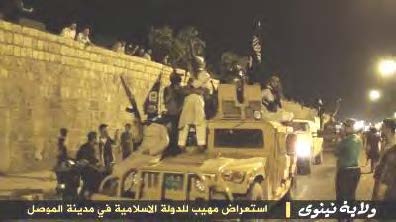
ISIS forces stage a victory parade in the streets of Mosul after its occupation (Twitter account of ISIS in Baghdad, June 24, 2014).
After the takeover of Mosul ISIS occupied the city of Tel Afar, about 50 kilometers, or 30 miles, west of Mosul. Most of its 80,000 inhabitants were Sunnis, with a Shi’ite minority. At the beginning of August 2014 ISIS forces took over the territory near the junction of the Iraqi, Syrian and Turkish borders. During the attack ISIS took control of the hydroelectric dam on the Tirgis, the largest in the country, located about 50 kilometers north of Mosul. The dam regulates the flow of the river and provides electricity for vast areas of Iraq. Forces belonging to the Peshmerga, the autonomous Kurdish Iraqi army, which were defending the dam, retreated after a battle lasting 24 hours (CNN.com, August 4, 2014).
At the same time as the attack on Mosul ISIS forces attacked Baiji, Tikrit and Samara, all north of Baghdad. On June 11, 2014, they took over the oil city of Baiji, located about 200 kilometers, or 125 miles, northwest of Baghdad, where the largest oil refinery in the country is located[26] (control of the city later passed to the Iraqi army, see below). On June 11, 2014, the city of Tikrit was also occupied; it is the capital of the Salah al-Din province and the birthplace of Saddam Hussein. The Iraqi army tried to recapture it but failed (See below). ISIS also threatened the Shi’ite holy city of Samara, but it was halted by Shi’ite militias dispatched to defend it.

Left: ISIS operatives hoist the organization’s flag at an Iraqi army post in the Nineveh province. Right: “Nineveh Unit” forces are briefed before battle (Longwarjournal.org, June 24, 2014)
Although the Kurdish Peshmerga were supposed to be a defensive force, they took the initiative at the beginning of the ISIS attack directed against the Iraqi regime. On June 12, 2014, they took over Kirkuk, whose control was disputed by the Kurdish autonomous region and the Iraqi administration. Apparently it was not only a Kurdish preemptive strike but exploited the opportunity to take over an important city with large oil reserves.
Containment and halt (second half of August – September)
During August and September 2014 ISIS continued its momentum, attacking in the north and south, with two goals: one, to take control of or gain a foothold in the important cities north of Baghdad (Baiji, Tikrit and Samara); and two, to extend its control in the area of Mosul and northern Iraq. This time, however, ISIS met with more determined resistance, especially from the Kurdish Peshmerga forces, which had adopted a more offensive posture, as opposed to their defensive posture of June. At this stage the Peshmerga and Iraqi army forces enjoyed increasing American aerial support, which contributed to the halt of the ISIS forces and also made it possible for them to retake several locations previously occupied by ISIS.
At this stage the situation on the ground was the following:
- The Mosul dam: On August 18, 2014, Peshmerga forces, with the support of the Iraqi army and the American air force, retook control of the strategically important Mosul dam. With American aerial support they also forced ISIS out of several villages to the north and east of Mosul.
- The oil city of Baiji: The Iraqi army forced the ISIS forces out of Baiji and its oil refinery. Since then ISIS forces have besieged the city, which is a logistic junction in the center of the country. They also have control of the oil pipes leading from the city and prevent the refinery from operating. Three days after American President Obama declared the campaign against ISIS, ISIS forces attacked the refinery with mortar shell fire and caused heavy damage to the oil tanks, setting them on fire (Note: In November 2014 the Iraqi security forces announced they had lifted the siege of Baiji).
- The city of Tikrit: After the Iraqi army tried twice, unsuccessfully, to take control of the city, on August 19, 2014, ISIS forces repelled another Iraqi army attempt at conquest. The Iraqi army was met with machine gun and mortar shell fire south of the city and with mines and sniper fire from the west. The Iraqi army declared it would make another attempt to capture the city.
- The Haditha dam on the Euphrates (the Qadisiya dam): The Haditha is a large dam on the Euphrates river in Al-Anbar province near the city of Haditha. It is the second largest dam in Iraq, and both regulates the flow of the Euphrates and produces electricity. In July 2014, ISIS’s Al-Anbar Unit attacked the Iraqi army base in Haditha. Between then and the beginning of September 2014 battles were fought for control of the dam. On September 8, 2014 Iraqi army forces supported by Sunni tribesmen and with American aerial support repelled the ISIS forces, driving them from the region around the dam. The area is now under Iraqi army control.
- Lifting the siege of the city of Amerli: Amerili, south of Kirkuk, was besieged for more than two months, since June 18, 2014. It is home to an estimated 15,000-17,000 Turkmen Shi’ites. ISIS considers them infidels, making them candidates for slaughter once the city was occupied. At the end of August 2014 the siege of Amerli was lifted after a joint attack of Shi’ite militias and Kurdish forces with American aerial support. In addition, the city of Sulaiman Bek, near Amerli, which had served as an ISIS stronghold, was captured. In addition to aerial cover for the forces, American, Australian, French and British planes dropped humanitarian aid to the inhabitants of Amerli “at the request of the government of Iraq” (Reuters.com, August 31, 2014).
Renewal of military attacks (end of September – updated to mid-November 2014)
At the end of September 2014 ISIS renewed its military attacks in the Sunni province of Al-Anbar. Its objectives were to take control over the entire province and to eliminate pockets of Iraqi army resistance, supported by Sunni tribesmen. The attacks may be considered as ISIS’s preparations for a future campaign against Baghdad. The main targets were the cities of Ramadi and Haditha, and the dam on the nearby Euphrates, all defended by Iraqi army forces with the support of Sunni tribesmen. ISIS also attacked the region north and northwest of Mosul, including Mt. Sinjar. The attacks are ongoing and clashes continue in various focal points.
In the attack on Al-Anbar province at the beginning of October ISIS attacked the city of Hit, located between Haditha and Ramadi. ISIS executed captured Iraqi army soldiers and dozens of Sunnis from the Albu Nimr tribe. At the beginning of October ISIS took control of a neighborhood in the southern part of Ramadi. At the end of October 2014 clashes were reported in the city of Abu Ghraib, west of Baghdad. In mid-November ISIS reported fierce battles in Ramadi, claiming that it controlled more than half the city.[27]
On the other hand, Iraqi army and Kurdish forces exerted pressure on ISIS and initiated by initiating military attacks in the areas south of Baghdad and around Baiji, the Rabia border crossing on the Iraq-Syria border, the northern town of Zumar. According to a statement from the Iraqi security forces, their greatest success so far was on November 14, 2014, when they lifted the siege of Baiji. It was broken by the Iraqi army and Shi’ite militias near the refinery compound. Among the Shi’ite militias the Iranian-supported “League of the Righteous” (asa’ib ahl al-haq)[28] was prominent, whose operatives played an important role in lifting the siege. The American air force provided aerial support for the Iraqi army and the Shi’ite militias (Longwarjournal.org, November 14, 2014).
At the same time, ISIS initiated a series of suicide bombing attacks in residential (especially Shi’ite) neighborhoods throughout Baghdad, to undermine order and sabotage daily life. According to Iraq Body Count, an Iraqi project that monitors the death toll in Iraq, during October 2014 590 people were killed in suicide bombing attacks. Most of them were carried out in Shi’ite neighborhoods in Baghdad or at roadblocks manned by Shi’ite fighters (Iraqbodycount.org, November 2, 2014).
Some of the attacks were the following:
- October 16, 2014 – Two car bombs driven by suicide bombers blew up in Al-Hurriya, a Shi’ite suburb of Baghdad. Three buildings collapsed and dozens of people were killed. ISIS claimed responsibility for the attack (Alnilin.com).
- October 17, 2014 – Three car bombs driven by suicide bombers blew up in busy areas in Baghdad. At least 25 people were killed (Aljazeera.net).
- October 19, 2014 – A suicide bomber wearing an explosive belt killed seventeen people at a Shi’ite mosque in the Al-Harithiyya neighborhood in western Baghdad.
- October 21, 2014 – A suicide bombing attack was one of three attacks carried out on the outskirts of the Kadhimiya neighborhood in northern Baghdad. At least 21 people were killed and 23 wounded. Among those killed were several policemen, including Ahmed al-Hafizi, commander of the Iraqi military police. ISIS claimed responsibility for two of the attacks (Alarabiya.net, October 14, 2014).
- October 27, 2014 – During the night a car bomb exploded in the center of Baghdad, killing at least 15 people. The area was home to Sunnis, Shi’ites and various ethnic minorities (Csmonitor.com, October 27, 2014).
- November 2, 2014 – A suicide bombing attack killed at least 14 Shi’ites during a march held for the Shi’ite holiday of Ashuraa. The suicide bomber blew himself up near a tent where Shi’ites had gathered (Dailystar.com, November 3, 2014).
ISIS efforts to establish control over Al-Anbar province have not yet ended. After it does take control, it may try to occupy Baghdad, topple the Iraqi regime, take over the government institutions and possibly declare Baghdad the capital of the Islamic Caliphate. However, Baghdad, with its large Shi’ite population, is liable to present fierce resistance to an ISIS takeover, including the Iraqi army and the Shi’ite militias with American and coalition aerial support (as well as Iran, which supports the Shi’ite Iraqi regime and regards itself as sponsoring the Shi’ites in Iraq).
ISIS and its allies may not be able to take over Baghdad with a rapid military attack as they did Mosul. ISIS knows that, and therefore its possible course of action may be to besiege the city and disrupt life to the point where it eventually surrenders. It can do that by cutting off the main roads leading to Baghdad, preventing supplies from reaching the local population and military reinforcements stationed in the city, damaging the infrastructure (by blowing up bridges, for example), firing rockets and mortar shells at the city and its suburbs, and detonating car bombs inside the city (a modus operandi at which ISIS has shown itself skilled).
However, according to American news reports based on anonymous American sources, the Iraqi army, with the support of the United States and the coalition countries, is planning a large-scale counterattack for the spring of 2015. Its objectives will be to liberate northern and western Iraq (including Mosul) from ISIS occupation and to restore Iraqi government control over the main roads and the region of the Iraq-Syria border (Nytimes.com, November 2, 2014). Carrying out such an attack will require overcoming major obstacles, including rebuilding the Iraqi army and increasing its order of battle in a relatively short period of time, while at the same time finding solutions for the complex political problems making it difficult for the central Iraqi government to function.
Executions of prisoners and killing of ethnic and religious minorities
Execution on Mosul
ISIS’s military occupations have been accompanied by executions and other atrocities targeting the Iraqi army (especially Shi’ite soldiers), government officials and ethnic and religious minorities ISIS regards as “infidels.” The executions are widely publicized by the social networks to frighten and deter ISIS’s enemies at home and abroad. They have in fact sown fear among population sectors targeted by ISIS, and have led to the mass exodus of residents and the increase of Iraq’s problem of displaced persons. According to the UN, after the occupation of Mosul about half a million people fled, most of them to the north towards Iraq’s autonomous Kurdish region (Nytimes.com, June 14, 2014; Al-Jazeera, June 23, 2014).
On June 22, 2014, a CNN report in Arabic was posted on YouTube, documenting the execution of Iraqi army soldiers who had been captured by ISIS. The video showed truckloads of corpses. It was probably filmed in Mosul, where hundreds of Iraqi soldiers were captured by ISIS forces. Most of the people photographed were wearing civilian clothing but some of them were in uniform.

The execution of Shi’ite Iraqi army personnel captured by ISIS. The Arabic reads, “This is the fate of the Shi’ites whom Nouri [al-Maliki] sent into battle against Sunnis” (Alplatformmedia.com)
Attack and harassing Christians
Attacks on the Christians in Mosul began immediately after the city was occupied. One of those who fled the city was Mosul Archbishop Nikodimos Daoud. Interviewed in Erbil, the capital of the Kurdish autonomous region, he said ISIS was planning to commit the genocide and ethnic cleansing of Mosul’s Christians. He said the Christians had been given the alternatives of conversion, a head tax or execution (Russian Today TV, July 23, 2014, according to MEMRI, August 8, 2014).
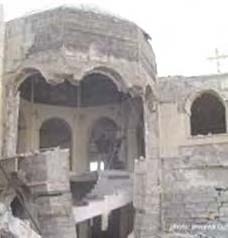
A Mosul church vandalized after ISIS occupation the city in June 2014. The media claimed that it had been demolished by IEDs (Abnar.ir).
Executions of Iraqi soldiers in Tikrit
On September 2, 2014, Human Rights Watch exposed reports of mass executions carried out by ISIS in Tikrit after its forces occupied the city on June 11, 2014. According to the reports, between 560 and 770 people were executed in Tikrit, most of them Iraqi soldiers who had been captured by ISIS forces. Human Rights Watch examined the evidence, including videos and satellite pictures, and found a number of gravesites in addition to those exposed in the past (Hrw.org, September 2, 2014).
Aid for the Yazidi on Mt. Sinjar
At the end of July–beginning of August 2014 ISIS forces took control of Sinjar, a city west of Mosul, the traditional stronghold of the Yazidi community. The Yazidi are a minority group of Kurdish extraction who have a complex religion with mystical ideas and ritual elements taken from ancient faiths.[29] The Yazidi were persecuted by the Ottoman Empire, which accused them of paganism. They were also persecuted by Saddam Hussein’s regime. ISIS regards them as “infidels” and gave them the choice given to all “infidels” in regions it occupies: convert or die. During its takeover of Sinjar ISIS murdered at least 500 Yazidi who refused to convert.
The Yazidi were brutally harassed by ISIS. A UN investigation dealing with the ISIS reign of terror in Syria and Iraq quoted Dabiq, an ISIS online magazine in English used for propaganda and recruitment, which reported what happened to Yazidi women captured by ISIS and divided among its operatives as “the spoils of war”[30] (Website of the UN Council for Human Rights, November 14, 2014).
Following the clear and present danger to their lives, between 3,000 and 4,500 Yazidi fled to Mt. Sinjar, near the Syrian border (according to other accounts, it was tens of thousands of refugees). They were without shelter, food or equipment. The United States air-dropped humanitarian aid and the Kurdish forcer from Syria (the YPG, the People’s Protection Units) and possibly the Turkish PKK (the Kurdistan Workers Party) went to Mt Sinjar, clashed with ISIS operatives and helped Yazidi escape to the al-Hasakah province in Syria, saving them from death.
During the first half of October 2014 ISIS operatives again attacked Mt. Sinjar, from the north. According to reports they took control of a number of villages and threatened the local Yazidi fighters. During the second half of October 2014 there were reportedly 750 families on Mt. Sinjar, about 5,000 Yazidi fighters and hundreds of YPG fighters (Alquds.co.uk, October 20, 2014; Shafaaq.com, October 20, 2014)
The establishment of a governmental system in Mosul
In Mosul and the other areas it occupied, ISIS set up a governmental network to establish its control over the population and fill the void created after the Iraqi government institutions collapsed in the wake of the ISIS occupation. ISIS followed it brutal practice of forcing the occupied population to adopt its extremist Islamic code of behavior and severely punished anyone who violated it. However, in some instances, Islamic law (the sharia) was enforced on the local population gradually to prevent excessive alienation.
ISIS’s propaganda machine tries to show that it successfully filled the governmental void created. Its information bureau in Mosul issued videos sending the message that daily life and commerce were conducted without disturbance. The ISIS information bureau in Kirkuk province issued pictures showing ISIS operatives cleaning and renovating streets, and doing maintenance work on electric lines and irrigation ditches (Al-Minbar Al-‘Alami Al-Jihadi, October 26, 2014). However, the videos and pictures were clearly propaganda and did not give an objective picture of the situation on the ground in the areas occupied by ISIS.
After taking over Mosul, the ISIS office of information issued a document detailing the rules of behavior demanded of the residents of Nineveh province, most of whom welcomed the organization. The document was entitled “the city charter” (wathiqat al-madinah). It explained the vision of the Islamic Caliphate and called on the Caliphate residents to enjoy the pleasures of Islam. It also demanded that they behave according to extremist Islamic codes. For example, women had to dress modestly (i.e., wear the niqab, a garment that covers the entire body, leaving only a slit for the eyes), and smoking was forbidden, as were alcohol and drugs. In addition, the shrines and graves of “polytheistic pagans” were to be destroyed, and all five daily prayers had to be performed.[31]
The “city charter” (similar to a “charter” issued in Al-Raqqah in Syria) also noted the release of prisoners from Iraqi government prisons and allegedly enabled security and other personnel affiliated with the Iraqi administration to “repent.”[32] The charter instructed people to return money belonging to the Iraqi regime to the Muslim Imam (i.e., Abu Bakr al-Baghdadi), who was responsible for funds. It warned against looting money and promised to bring to trial and punish “gangs of looters.” It also made it clear that ISIS would not stand for the existence of rival organizations and that it would not allow civilians to carry weapons or wave any flag other than the ISIS flag. Anyone who broke the law would be severely punished either with death or corporal punishment (i.e., thieves would have their hands cut off).

The Mosul “city charter” issued by ISIS after the occupation of Nineveh province (Baqiya.blogspot.fr, June 12, 2014)
The establishment of an educational system in Iraq
As in Syria, in Iraq ISIS established educational institutions that taught its curriculum, which replaced the national Iraqi governmental curriculum. It was presented to the residents of Mosul in a two-page bulletin posted in the mosques, markets and electricity poles. Dated September 5, 2014, it reported “good news of the establishment of the Islamic State Education Diwan by the caliph who seeks to eliminate ignorance, to spread religious sciences and to fight the decayed curriculum” (AP.org, September 15, 2014).[33]
Many residents of Mosul have reservations about the new curriculum because of its Salafist-jihadi nature. According to the Associated Press, may pupils have not shown up for class because of their parents’ concern for their safety. The AP’s sources said families were keeping their children home out of mixed feelings of fear, resistance and uncertainty. A Mosul resident identified as “Abu Hassan” told the AP that “What’s important to us now is that the children continue receiving knowledge correctly, even if they lose a whole academic year and an official certification.” He and his wife, he said, opted for home schooling (AP.org, September 15, 2014).[34]
The establishment of judicial and enforcement systems in Iraq
ISIS has established judicial and enforcement networks in areas under its control in Iraq. After the occupation of Mosul it set up eight Islamic courts to try former Iraqi government officials (Almayadeen.net, June 20, 2014).
As in Syria, ISIS set up an enforcement system called “the Islamic police” (al-shurta al-islamiyya). It includes uniformed policemen equipped with cars and light and medium-weight arms allegedly to “protect Muslims” in the various provinces (Vrontatke social media account for ISIS in the Euphrates province, September 12, 2014). It can be assumed that as in Syria, in Iraq the morality police (al-hisbah) also operate alongside the regular local police to enforce religious Islamic law on the local residents.

Left: A beheading, the punishment meted out by a sharia court (Qanon302.net). Right: A public whipping, the punishment meted out by a sharia court (Qanon302.net).
Symbols of rule: issuing passports and the intention to mint coins
As part of the self-declared Islamic Caliphate’s administration and rule, ISIS issued official Islamic Caliphate passports at the beginning of July 2014. According to reports, 11,000 passports were initially issued to civilians in the Iraqi regions under ISIS control. To issue them ISIS used the Iraqi administration’s identity card and passport center.
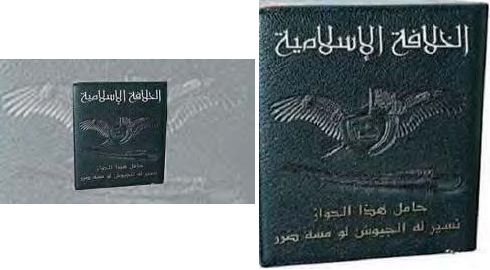
An ISIS “Islamic Caliphate” passport. The Arabic at the bottom reads, “The bearer of this passport has behind him our armies, if [any] damage befalls him.” In the center, flanked by the wings of an eagle, is a mosque flying a flag emblazoned with the shahada (the Islamic testimony “There is no god but Allah, and Muhammad is his prophet”). Below the symbol is a sword (Sharkiapost.com)
On November 13, 2014, the Islamic State (IS) announced that following an order from “the Caliph Ibrahim” [i.e., Abu Bakr al-Baghdadi] IS would mint coins to replace the currency in use in Syria and Iraq. The new coins will be minted from gold, silver and copper. The coin-minting project will be discussed in ISIS’s institutions, including the Shura Council Al-Minbar Al-‘Ilami Al-Jihadi, November 13, 2014).
On November 12, 2014, the London-based Arabic newspaper Al-Sharq Al-Awsat reported that ISIS planned to restore the use of gold and silver dinars. Its objective is to strengthen its control over the regions of the Caliphate and as part of its struggle against the West. The gold and silver dinars ISIS wants to return to use were used during the early days of Islam. Every coin will be stamped with an Islamic quote on one side and the date of its minting and name of the governor on the other.
At the beginning of June 2014 it was reported that ISIS would soon begin issuing ID cards (Yenisafak.com.tr and Assabeel.net, July 5, 2014). So far it has not been ascertained whether ISIS has issued ID cards to civilians living in the areas under its control, but it may do so in the future.
Enlisting new operatives into the ranks of ISIS
ISIS’s military achievements in Iraq, the self-declaration of the establishment of the Islamic Caliphate in the summer of 2014 and the losses sustained by the organization in military campaigns forced the organization to rapidly enlarge its order of battle and led it to make an effort to enlist and train new operatives in both Iraq and Syria. Its financial capabilities enabled ISIS to tempt young Iraqis and Syrians to enlist by paying them higher salaries than those usual in their home countries. However, it was also reported that pressure was exerted on the local population to “convince” young men to enlist in its ranks.
ISIS recruited local operatives in the various provinces of Iraq. The new recruits underwent training in camps for several months and were integrated into ISIS’s military force and administrative institutions. The number of new operatives entering the ranks of ISIS in Iraq and Syria in the summer of 2014 is estimated at several thousand. More than 6,300 fighters, most of them Syrian, joined the organization in July 2014 alone (Gulfnews.com, August 30, 2014).
ISIS has 11 identified training camps in Iraq out of 25. They are located in the provinces Al-Anbar, Salah al-Din and Nineveh, and in the Kirkuk and Mosul areas (Longwarjournal.org, October 24 and November 22, 2014). ISIS occasionally posts pictures of trainees and graduations exercises held in the training camps. For example, in October 2014 it posted pictures from the graduation exercises of a training course held at a camp in the Kirkuk region named for Sheikh Abu Omar al-Baghdadi (who headed ISI and was killed in a targeted American attack). Some of the pictures follow, all posted on the ISIS forum, Hanein.info on October 3, 2014):
![]()
[1] Links to all other nine sections:
You can read the overview — “ISIS: Portrait of a Jihadi Terrorist Organization” — here.
You can read section 1 — “The historical roots and stages in the development of ISIS” — here.
You can read section 2 — “ISIS’s ideology and vision, and their implementation” — here.
You can read section 4 — “ISIS establishes itself in eastern and northern Syria” — here.
You can read section 5 — “ISIS’s capabilities: the number of its operatives, control system, military strength, leadership, allies and financial capabilities” — here.
You can read section 6 — “Exporting terrorism and subversion to the West and the Arab world” — here.
You can read section 7 — “ISIS’s propaganda machine” — here.
You can read section 8 — “The American campaign against ISIS” — here.
You can read section 9 — “ISIS response to the American campaign (update to mid-November 2014)” — here.
![]()
Notes:
[25] Ramadi, Al-Anbar’s capital city, and the surrounding territories are still not fully under ISIS control. Clashes continue between ISIS and the Iraqi army for control of the city and its surroundings (updated to mid-November 2014).
[26] The oil refinery compound is located halfway between Mosul and Baghdad. It can distill 310,000 barrels a day, supplying fuel for northern Iraq and 11 provinces, including Baghdad. The region is also home to a power plant that provides the electricity for most of northern Iraq (Nytimes.com, June 18, 2014). During the first half of 2014 the oil refinery produced 48% of the country’s petroleum distillates (Gulfnews.com, September 14, 2014).
[27] Ramadi is home to Sheikh Ahmed Abu Risha, the leader of a powerful tribe which was formerly an American ally. His and other Sunni tribes fought at the side of the Iraqi army in Ramadi, Fallujah and other cities in Al-Anbar province (Longwarjournal.org, November 16, 2014).
[28] “The League of the Righteous” is an Iraqi Shi’ite militia established in 2006 by the Iranian Qods Force and operating under its aegis. Its operatives are supported by Hezbollah in Lebanon. Before the Americans withdrew from Iraq the militia carried out a series of attacks against the United States and its allies, including abductions, rocket fire and detonating IEDs. The militia specialized in the use of explosively formed projectiles (EFPs), placing them along routes used by the American army. Its operatives, who became unemployed with the Americans withdrew from Iraq, were sent to Syria to support the Syrian army, where they were directed and encouraged by Iran.
[29] There are close to a million Yazidi in the world today (maximum estimate). About two thirds of them live in northern Iraq, most of them in the Nineveh province. Most experts are of the opinion that the name Yazidi comes from the name of the second Umayyad Caliph, Yazid bin Muawiyah, whose army defeated the Shi’ite Imam Hussein bin Ali at the battle of Karbala. The Yazidi consider Yazid bin Muawiyah an incarnation of the Divinity. Yazidi culture is Kurdish and most Yazidi speak Kurmanji, a holy language unique to the community. The Yazidi religion is influenced by Islamic Sufism, but most of its beliefs are not related to Islam and to a great extent its cosmology is reminiscent of ancient Persian faiths.
[30] The concept of minority-group captives as spoils of war were explained by an ISIS operative to the Egyptian terrorist organization Ansar Bayt al-Maqdis on the ISIS forum on November 4, 2014 (See below). One of ISIS’s suggestions was for jihadi fighters in Egypt to attack Christians and Shi’ites. The reason was “because they are sectarian groups that cannot be trusted and with whom no agreement can be reached. They are nothing more than the spoils of war given to you by Allah.”
After capture, the Yazidi women and children were then divided according to the Shariah amongst the fighters… who participated in the Sinjar operations, after one-fifth of the slaves were transferred to the IS’s authority to be divided as khums [spoils of war]. –DABIQ (ISIS publication)
[31] For a full discussion of the “city charter” see “The Islamic State of Iraq and Syria Has a Consumer Protection Office” by Aaron Zelin at The Atlantic, June 13, 2014.
[32] In reality, after the occupation of Mosul ISIS executed hundreds of captives without allowing them “to repent.”



 RSS
RSS


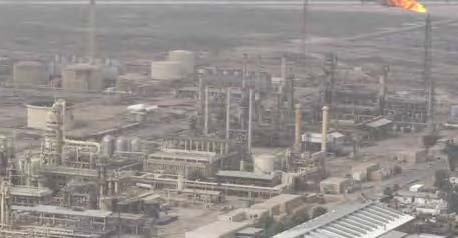
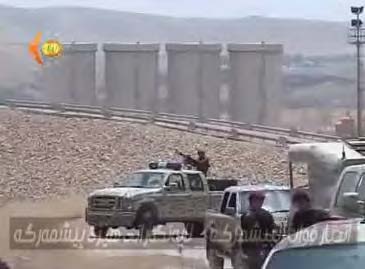














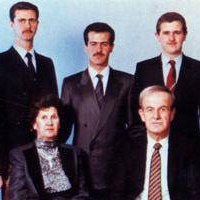







Latest Comments
Hello Mike, Thank you for your positive feedback to the article. I felt there wasn’t too much critical analysis of ...
Thanks for this considered and well constructed article. A follow up article on the manner in which the editorial contro...
THE CLUELESSNESS OF CLAIMING THAT OBAMA'S MIDDLE EAST POLICIES WERE A FAILURE CANNOT BE FURTHER FROM THE TRUTH, WHAT THE...
As long as Obama is the president of the usa do not trust the us government......
Thank you for an good read....